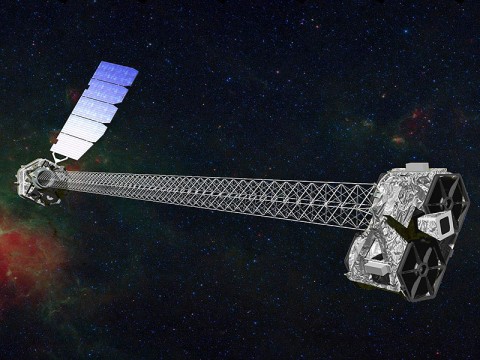Written by Dr. Tony Phillips
Science at NASA
 Washington, D.C. – Deep in the heart of the spiral Milky Way galaxy, a hot vortex of matter swirls around a black hole more than a million times as massive as the sun.
Washington, D.C. – Deep in the heart of the spiral Milky Way galaxy, a hot vortex of matter swirls around a black hole more than a million times as massive as the sun.
Many galaxies, perhaps all, contain such a “monster in the middle.” These supermassive black holes sustain themselves by swallowing stars, planets, asteroids, comets and clouds of gas that wander by the crowded galactic core.
NASA’s NuSTAR spacecraft recently caught the Milky Way’s central black hole in the act of having a snack.
[youtube]http://www.youtube.com/watch?v=UP7ig8Gxftw[/youtube]
“We got lucky and captured an outburst from the black hole during our [first] observing campaign,” says Fiona Harrison, the mission’s principal investigator at the California Institute of Technology.NuSTAR is an orbiting observatory designed to take pictures of violent, high-energy phenomena in the universe. Launched on June 13th, 2012, it is the only telescope capable of producing focused images of the highest-energy X-rays produced by dying stars and ravenous black holes.
“It’s like putting on a new pair of glasses and seeing aspects of the world around us clearly for the first time,” says Harrison. NuSTAR’s first light image of Cygnus X-1, a black hole in our galaxy that is siphoning gas off a giant-star companion, shows what she’s talking about: click here
NuSTAR’s sharp vision allowed it to pinpoint a burst of hard X-rays coming from the galactic center during an observing campaign in July. Lower-energy X-ray observations by NASA’s Chandra X-ray Observatory and infrared data from the Keck telescope in Hawaii confirmed the outburst. The Milky Way’s black hole had just swallowed … something.

Black hole snacks are a violent process in which the “meal” is ripped apart by powerful tides and heated to millions of degrees as it slides down the gullet of the gravitational singularity. In this case, NuSTAR picked up X-rays emitted by matter being heated up to about 100 million degrees Celsius.
The observation raises hopes that astronomers will be able to solve a long-standing mystery: Why is the Milky Way’s supermassive black hole such a picky eater?
Asteroids could be a primary food source. One model holds that trillions of asteroids surround the Milky Way’s core. Astronomers using the Chandra X-ray Observatory have indeed detected flares consistent with asteroids 10 km wide or larger falling into the black hole.
These space rocks would be about the same size as the asteroid that wiped out the dinosaurs on Earth 65 million years ago. Smaller space rocks might be falling in, too, but their flares would be too weak for Chandra to detect.
NuSTAR brings something new to the problem. With its unprecedented ability to detect and make focused images of X-ray flares, the telescope will almost certainly help astronomers understand what’s happening deep in the core of our galaxy. The monster’s menu might soon be revealed.
For more information about NuSTAR and its focused observations of black holes, visit the mission’s home page at nustar.caltech.edu.


